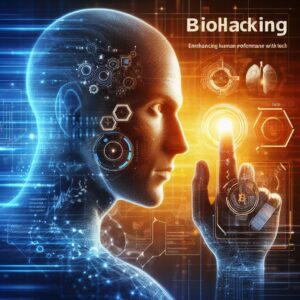Biohacking: Enhancing Human Performance with Tech
In recent years, a new trend has emerged in the world of health and wellness—biohacking. Biohacking is the practice of making changes to your lifestyle, diet, and environment with the aim of enhancing your physical and mental performance. It involves utilizing various technologies and techniques to optimize human biology and unlock our full potential. This article will explore the concept of biohacking, its applications, and the potential impact it can have on human performance.
Table of Contents
- Introduction
- What is Biohacking?
- The Origins of Biohacking
- Biohacking Techniques
- Nutrigenomics
- Quantified Self
- Wearable Technology
- Cognitive Enhancement
- Genetic Engineering
- Cryotherapy
- Mindfulness and Meditation
- Sleep Optimization
- Exercise and Fitness
- Nootropics
- Biofeedback
- Transcranial Magnetic Stimulation (TMS)
- Microbiome Manipulation
- Longevity Hacks
- DIY Biology
- Benefits of Biohacking
- Ethical Considerations
- The Future of Biohacking
- Conclusion
- FAQs
1. Introduction
In a world where constant improvement and peak performance are highly sought after, biohacking has gained significant attention. People are no longer content with relying solely on traditional methods to enhance their capabilities. Instead, they are turning to science, technology, and self-experimentation to push the boundaries of human potential.
2. What is Biohacking?
Biohacking refers to the practice of making deliberate changes to one’s lifestyle and environment in order to optimize one’s physical and mental performance. It involves using various tools, technologies, and techniques to improve overall well-being, increase energy levels, boost cognitive function, and achieve optimal health.
3. The Origins of Biohacking
The concept of biohacking can be traced back to the 1980s when computer hackers started applying their problem-solving skills and innovative thinking to biology. These early biohackers were driven by the desire to understand and manipulate biological systems for the betterment of humanity. Over time, biohacking has evolved and expanded to encompass a wide range of practices and disciplines.
4. Biohacking Techniques
Biohacking encompasses a diverse array of techniques and approaches. Here are some of the most commonly used methods:

4.1 Nutrigenomics
Nutrigenomics explores the interaction between nutrition and gene expression. It involves tailoring your diet to suit your unique genetic makeup, allowing you to optimize your nutrition and improve overall health.
4.2 Quantified Self
Quantified self refers to the practice of tracking and analyzing personal data, such as heart rate, sleep patterns, and cognitive performance. By collecting and analyzing this data, individuals can gain insights into their own bodies and make informed decisions to optimize their health and performance.
4.3 Wearable Technology
Wearable technology, such as fitness trackers and smartwatches, allows individuals to monitor various aspects of their health and well-being in real-time. These devices can track metrics like heart rate, sleep quality, and physical activity, providing valuable data for biohackers to optimize their lifestyle choices.
4.4 Cognitive Enhancement
Cognitive enhancement involves using techniques and technologies to improve cognitive abilities, such as memory, focus, and problem-solving. This can include practices like brain training exercises, meditation, and the use of nootropic supplements.
4.5 Genetic Engineering
Genetic engineering involves modifying the genetic material of living organisms, including humans, to enhance certain traits or capabilities. While this area of biohacking is still in its early stages, it holds immense potential for the future.
4.6 Cryotherapy
Cryotherapy is the practice of exposing the body to extremely cold temperatures for a short period of time. It is believed to have various benefits, such as reducing inflammation, improving muscle recovery, and boosting overall well-being.
4.7 Mindfulness and Meditation
Mindfulness and meditation are practices that involve training the mind to focus on the present moment. These techniques have been shown to reduce stress, improve mental clarity, and promote overall well-being.
4.8 Sleep Optimization
Sleep optimization techniques aim to improve the quality and duration of sleep. This can include practices like creating a sleep-friendly environment, establishing a consistent sleep routine, and using tools like sleep trackers to monitor and analyze sleep patterns.
4.9 Exercise and Fitness
Regular exercise is a fundamental aspect of biohacking. By engaging in physical activity, individuals can improve cardiovascular health, enhance strength and endurance, and boost overall fitness levels.
4.10 Nootropics
Nootropics are substances that are believed to enhance cognitive function. These can include natural compounds like herbs and adaptogens, as well as synthetic drugs that have cognitive-enhancing properties.
4.11 Biofeedback
Biofeedback involves using sensors to monitor physiological signals from the body, such as heart rate, skin conductance, and brainwave activity. By providing real-time feedback, biofeedback allows individuals to gain control over their bodily functions and optimize their performance.
4.12 Transcranial Magnetic Stimulation (TMS)
Transcranial Magnetic Stimulation is a non-invasive technique that uses magnetic fields to stimulate specific areas of the brain. It has been used to treat various mental health conditions and shows potential for enhancing cognitive abilities.
4.13 Microbiome Manipulation
The human microbiome refers to the trillions of microorganisms that live in and on our bodies. Biohackers are exploring ways to manipulate the microbiome to improve digestion, strengthen the immune system, and promote overall health.
4.14 Longevity Hacks
Longevity hacks are strategies and interventions aimed at extending human lifespan and slowing down the aging process. These can include practices like calorie restriction, intermittent fasting, and the use of anti-aging supplements.
4.15 DIY Biology
DIY biology involves individuals conducting scientific experiments and research in non-traditional settings, such as home labs or community spaces. It allows enthusiasts to explore and experiment with biological systems, fostering innovation and knowledge-sharing.
5. Benefits of Biohacking
Biohacking offers several potential benefits for individuals who are looking to enhance their performance and improve their overall well-being. Some of the benefits include:
- Increased energy levels
- Enhanced cognitive function
- Improved physical fitness and strength
- Better sleep quality
- Reduced stress and anxiety
- Optimal nutrition and weight management
- Enhanced longevity and aging gracefully
6. Ethical Considerations
While biohacking holds immense promise, it also raises ethical considerations. As technology advances and individuals gain more control over their biology, questions arise regarding the potential risks and consequences of certain biohacking practices. It is crucial to ensure that biohacking is carried out responsibly, with proper consideration given to safety, privacy, and the potential impact on society as a whole.
7. The Future of Biohacking
The field of biohacking is still in its early stages, and there is much more to discover and explore. As technology continues to advance, we can expect to see new and innovative biohacking techniques emerging. From personalized medicine to advanced genetic engineering, the future of biohacking holds tremendous potential for revolutionizing human health and performance.
8. Conclusion
Biohacking is a fascinating field that offers individuals the opportunity to optimize their physical and mental performance through the use of technology and lifestyle modifications. By harnessing the power of biohacking, we can unlock our full potential and achieve new levels of health, well-being, and human performance.
FAQs
Q1: Is biohacking safe? A1: While many biohacking practices are safe when done responsibly, it is essential to approach biohacking with caution and seek professional guidance when necessary.
Q2: Do I need expensive equipment to biohack? A2: Not necessarily. While some biohacking tools and technologies can be expensive, there are many low-cost or DIY options available that can still yield positive results.
Q3: Can anyone become a biohacker? A3: Yes, anyone can explore biohacking and incorporate biohacking techniques into their lifestyle. However, it is important to educate yourself and seek reliable information before starting any biohacking practices.
Q4: Are there any risks associated with biohacking? A4: Like any other practice that involves making changes to your body or lifestyle, there are potential risks associated with biohacking. It is crucial to approach biohacking with care, do thorough research, and consult with professionals when needed.
Q5: How long does it take to see results from biohacking? A5: The timeline for seeing results from biohacking varies depending on the specific techniques and interventions used. Some changes may be noticeable relatively quickly, while others may require more time and consistency.
